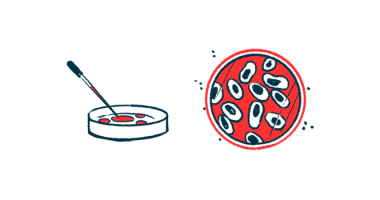CNM-Au8 for Parkinson’s disease
Last updated Nov. 18, 2024, by Margarida Maia, PhD

What is CNM-Au8 for Parkinson’s disease?
CNM-Au8 is an investigational oral solution of gold nanocrystals being developed by Clene Nanomedicine as a disease-modifying treatment to slow or prevent neurodegeneration in people with Parkinson’s disease.
The company is also testing CNM-Au8 for amyotrophic lateral sclerosis — for which the therapy received orphan drug status from the U.S. Food and Drug Administration — and for multiple sclerosis (MS).
Therapy snapshot
| Treatment name: | CNM-Au8 |
| Administration: | Being tested as an oral solution |
| Clinical testing: | Tested in a Phase 2 clinical trial; being considered for Phase 3 testing |
How does CNM-Au8 work?
Parkinson’s is caused by the progressive degeneration and death of dopaminergic neurons in the brain. Dopaminergic neurons are nerve cells that produce dopamine, a signaling chemical involved in the control of body movement. As a result, people with Parkinson’s experience motor symptoms, which typically include slowness of movement, tremor, stiffness, and difficulty with balance and walking.
Why exactly dopaminergic neurons become prone to die in Parkinson’s is not completely understood, but mitochondria appear to play a role. Mitochondria are bean-shaped structures inside cells. They are often referred to as the cells’ powerhouses because they use glucose (sugar) as fuel to produce adenosine triphosphate (ATP), a high-energy molecule that cells need to function. Toxic byproducts known as free radicals are formed as part of the process to produce ATP.
Free radicals are normally counteracted by antioxidants present in cells. However, too many free radicals (or not enough antioxidants) can cause oxidative stress, which is damaging to cells.
In Parkinson’s, poorly functioning mitochondria may not be able to produce enough ATP to match the high energy demands of dopaminergic neurons. They also may throw the antioxidant response off balance, causing oxidative stress.
CNM-Au8 contains pure gold nanocrystals, which are tiny, orderly arranged lattices grown from gold ions, that are designed to restore the levels of energy that dopaminergic neurons and other cells of the nervous system need to stay healthy and survive. Gold nanocrystals can convert nicotinamide adenine dinucleotide (NAD), a chemical compound, from one of its two forms (NADH) into the other (NAD+). NAD+ is needed for the process to produce ATP, so having more NAD+ is expected to increase the energy output of mitochondria.
Gold nanocrystals also scavenge cells for free radicals or other harmful oxygen-containing molecules, reducing the oxidative stress that drives damage in neurodegenerative diseases like Parkinson’s.
In the blood, CNM-Au8 attracts apolipoproteins to its surface. Apolipoproteins are proteins that bind lipids (fats) to form lipoproteins, which naturally cross the blood-brain barrier. This barrier is a semipermeable seal that keeps harmful substances from reaching the brain. Helped by apolipoproteins, CNM-Au8 can bypass this barrier which would otherwise limit its distribution into the brain, where it is needed to protect dopaminergic neurons from dying.
In preclinical studies, CNM-Au8 improved the survival and function of lab-grown rat dopaminergic neurons by keeping mitochondria healthy and reducing the levels of harmful oxygen-containing molecules. It also prevented alpha-synuclein protein from building up to form abnormal protein clumps that drive the death of dopaminergic neurons in Parkinson’s. In a rat model of Parkinson’s, CNM-Au8 was found to be better than a placebo at easing motor symptoms of the disease.
How is CNM-Au8 administered?
CNM-Au8 is a dark red to purple drinkable solution of gold nanocrystals. In clinical testing in Parkinson’s, CNM-Au8 was given at doses of 7.5, 15, 30, or 60 milligrams (mg) in a volume of 120 milliliters (mL) of sodium bicarbonate buffered water.
CNM-Au8 in clinical trials
CNM-Au8 was first tested in a Phase 1 clinical trial (NCT02755870) that enrolled 86 healthy volunteers, ages 18 to 45. Participants were randomly assigned to CNM-Au8 at single-ascending or multiple-ascending doses of 15, 30, 60, or 90 mg, or to a placebo.
CNM-Au8 was found to be safe and well tolerated. Most side effects were mild, and there were no side effects that were considered serious or led to discontinuing treatment.
Based on these findings, Clene launched a pilot Phase 2 clinical trial to gain proof of concept of CNM-Au8 for the treatment of Parkinson’s.
Phase 2 clinical trial
An open-label Phase 2 clinical trial, called REPAIR-PD (NCT03815916), tested CNM-Au8 in 13 adults (seven men, six women) with idiopathic Parkinson’s, mean age of 65.9 years, who had received their diagnosis on average 1.5 years before enrolling in the study. All were on standard medications for Parkinson’s, with nine (70%) being on the gold-standard treatment carbidopa/levodopa only.
All Parkinson’s patients were given an oral solution of CNM-Au8 at a dose of 15 or 30 mg once daily for 12 weeks, or about three months. The main goal was to watch for changes in the ratio of NAD+ to NADH from baseline (the study’s start) to week 12.
Data from the 13 patients were combined with data from 11 adults with MS who took part in another proof-of-concept Phase 2 clinical trial of CNM-Au8, called REPAIR-MS (NCT03993171).
Over the 12 weeks of treatment, CNM-Au8 significantly increased the ratio of NAD+ to NADH in the brain, on average, by 10.4%. The levels of NAD+ increased significantly, whereas those of NADH decreased, suggesting a shift toward more energy output. The same trends were observed when considering data from REPAIR-PD alone, but the differences were not significant.
People with Parkinson’s showed an easing of motor symptoms on daily life after four weeks of treatment with CNM-Au8, as measured using part 2 of the Movement Disorders Society – Unified Parkinson’s Disease Rating Scale. However, researchers considered the change might have been driven by the so-called placebo effect, which can occur due to patients’ expectations that a treatment will help.

Common side effects of CNM-Au8
CNM-Au8 has been well tolerated in trials with Parkinson’s patients. Most side effects in clinical testing were transient and mild to moderate in severity. The most commonly reported side effects included:
- inflammation of the nose and throat (sinusitis and nasopharyngitis)
- sensations of tingling or numbness (paresthesia).
Parkinson’s News Today is strictly a news and information website about the disease. It does not provide medical advice, diagnosis, or treatment. This content is not intended to be a substitute for professional medical advice, diagnosis, or treatment. Always seek the advice of your physician or other qualified health provider with any questions you may have regarding a medical condition. Never disregard professional medical advice or delay in seeking it because of something you have read on this website.
Recent Posts
- Navigating the effects of Parkinson’s disease on speech, part 3
- NIH consortium to explore gut-brain connection in Parkinson’s
- Researchers ID 3 genes linked to disease activity in Parkinson’s
- Tavapadon’s flexible dose eases symptoms in early Parkinson’s
- Potential diagnostic tool finds protein clumps in living cells
Related articles






